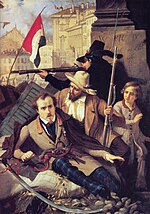Description
The museum was founded on a collection of documents on the Risorgimento, gathered for the Exhibition of Turin in 1884 and then moved to the showroom at Milan’s Public Gardens. The exhibition was later transferred to the Rocchetta rooms at the Sforza Castle, where it was officially inaugurated on 24 June 1896. In 1943, due to the war-time bombardment of the castle, the museum was temporarily moved to the estate of Casa Manzoni (home of the famed Italian poet and novelist Alessandro Manzoni). Finally in 1951 it was housed inside the Moriggia Palace, where it remains today. [1]
The museum is part of the Civic Historical Collections. Its collections include Baldassare Verazzi's Episode from the Five Days and Francesco Hayez's 1840 Portrait of Emperor Ferdinand I of Austria . The permanent exhibition is displayed to follow the chronological order of events of the Risorgimento, leading the visitor through fifteen rooms, to which the new Weapons Room has been recently added. The latest refurbishment in 1998 included the redesign of the permanent exhibitions, to accentuate the highlights of the collections, particularly the relics.
The museum boasts the green-and-silver velvet cloak and the valuable regal insignia of Napoleon Bonaparte’s coronation, the banner of the Legione Lombarda Cacciatori a Cavallo (Lombard Legion on Horseback) and the first Italian flag. The last renovation saw the redesign of the lighting and information systems, as well as improvements to the ‘Romantic Garden’ behind the building. [2]
This page is based on this
Wikipedia article Text is available under the
CC BY-SA 4.0 license; additional terms may apply.
Images, videos and audio are available under their respective licenses.










